Table of Contents
Historic trends in structure heights
Published 12 July, 2018; last updated 23 April, 2020
Trends for tallest ever structure heights, tallest ever freestanding structure heights, tallest existing freestanding structure heights, and tallest ever building heights have each seen 5-8 discontinuities of more than ten years. These are:
- Djoser and Meidum pyramids (~2600BC, >1000 year discontinuities in all structure trends)
- Three cathedrals that were shorter than the all-time record (Beauvais Cathedral in 1569, St Nikolai in 1874, and Rouen Cathedral in 1876, all >100 year discontinuities in current freestanding structure trend)
- Washington Monument (1884, >100 year discontinuity in both tallest ever structure trends, but not a notable discontinuity in existing structure trend)
- Eiffel Tower (1889, ~10,000 year discontinuity in both tallest ever structure trends, 54 year discontinuity in existing structure trend)
- Two early skyscrapers: the Singer Building and the Metropolitan Life Tower (1908 and 1909, each >300 year discontinuities in building height only)
- Empire State Building (1931, 19 years in all structure trends, 10 years in buildings trend)
- KVLY-TV mast (1963, 20 year discontinuity in tallest ever structure trend)
- Taipei 101 (2004, 13 year discontinuity in building height only)
- Burj Khalifa (2009, ~30 year discontinuity in both freestanding structure trends, 90 year discontinuity in building height trend)
Details
Background
Over human history, the tallest man-made structures have included mounds, pyramids, churches, towers, a monument, skyscrapers, and radio and TV masts.
Height records often distinguish between structures and buildings, where a building is ‘regularly inhabited or occupied’ according to Wikipedia, or is ‘designed for residential, business or manufacturing purposes’ and ‘has floors’ according to the Council on Tall Buildings and Urban Habitat.1 Figure 1a is an illustration from Wikipedia showing the historic relationship between the heights of buildings and structures.2
Figure 1a: Recent history of tall structures by type.3
Height records also distinguish ‘freestanding’ structures from other structures. According to Wikipedia, “To be freestanding a structure must not be supported by guy wires, the sea or other types of support. It therefore does not include guyed masts, partially guyed towers and drilling platforms but does include towers, skyscrapers (pinnacle height) and chimneys.”4 Definitions vary, for instance Guinness World Records apparently treats underwater structures as ‘freestanding’.5 We ignore underwater height in general, excluding underwater structures from ‘freestanding’ records and and ‘all structures’ records.
The heights of buildings in particular are commonly measured in terms of ‘architectural height’ or ‘height to tip’, which both start at the lowest, significant, open-air, pedestrian entrance, but differ in that ‘to tip’ includes ‘functional-technical equipment’ like antennae, signage or flag poles, while architectural height does not6 Our understanding is that ‘pinnacle height’ is the same as ‘height to tip’. There are also several less common measures in use.
Height records must also distinguish between the tallest structure standing at a given time, and the tallest structure to have ever existed, at that time. The tallest building or structure at a particular time is sometimes not the tallest ever, when the tallest is damaged without anything taller being built. For instance, the tallest structures in the 1700s were shorter than earlier records, because those were church spires which became damaged without replacement (see Figure 1b).
Figure 1b: An illustration of structure heights over time by location from Wikipedia. 7 (Click to enlarge)
Trends
We collected data for several combinations of measurement possibilities mentioned:
- Tallest ever structures on land (i.e. freestanding or not, but not underwater), measured to tip
- Tallest ever freestanding structures, measured to tip
- Tallest existing freestanding structures, measured to tip
- Tallest ever buildings, measured to architectural height
Tallest ever structure heights
Data
We collected height records from numerous Wikipedia lists of tall buildings and structures.8 We have not extensively verified these sources, though we made minor adjustments and additions from elsewhere online where sources were inconsistent or records incomplete. Our data is in this spreadsheet, sheet ‘Structures collection’. Figure 2 shows this data.
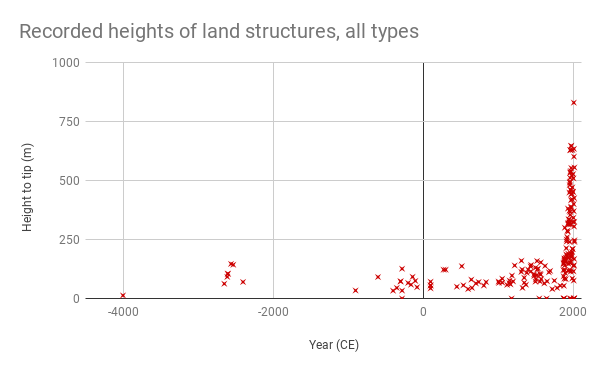
We constructed a timeline of tallest ever structures by pinnacle height from the tallest ever records in this dataset (see sheet ‘Structures (all time, pinnacle)’ in the spreadsheet). This is shown in figures 3a and 3b below.
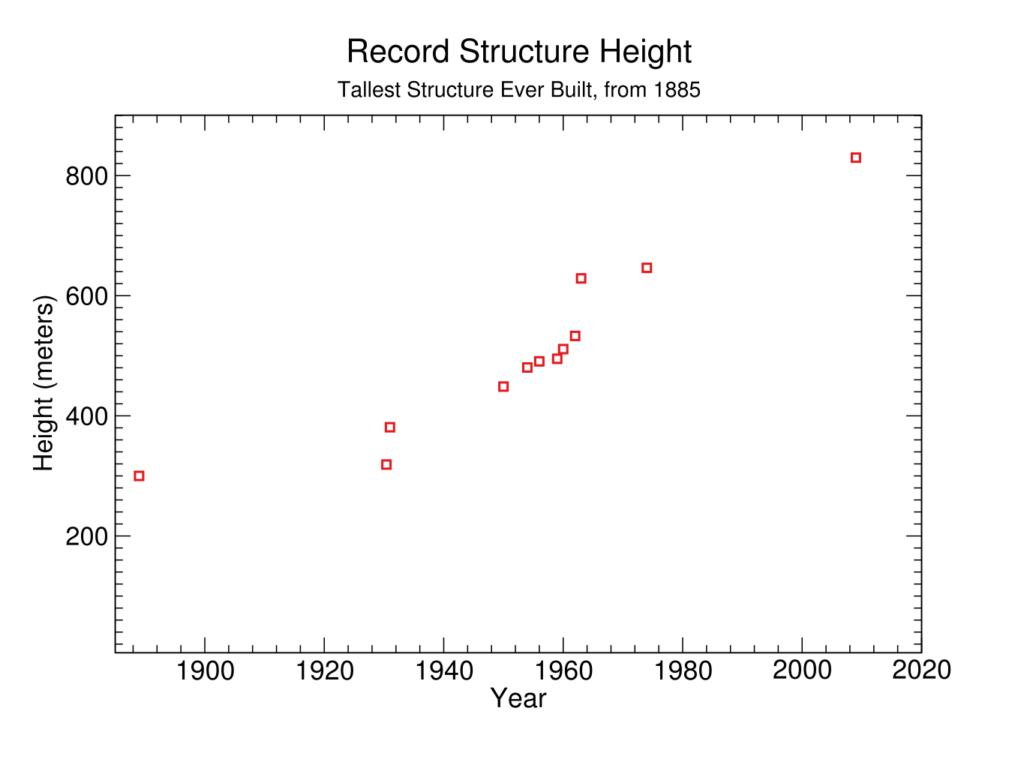
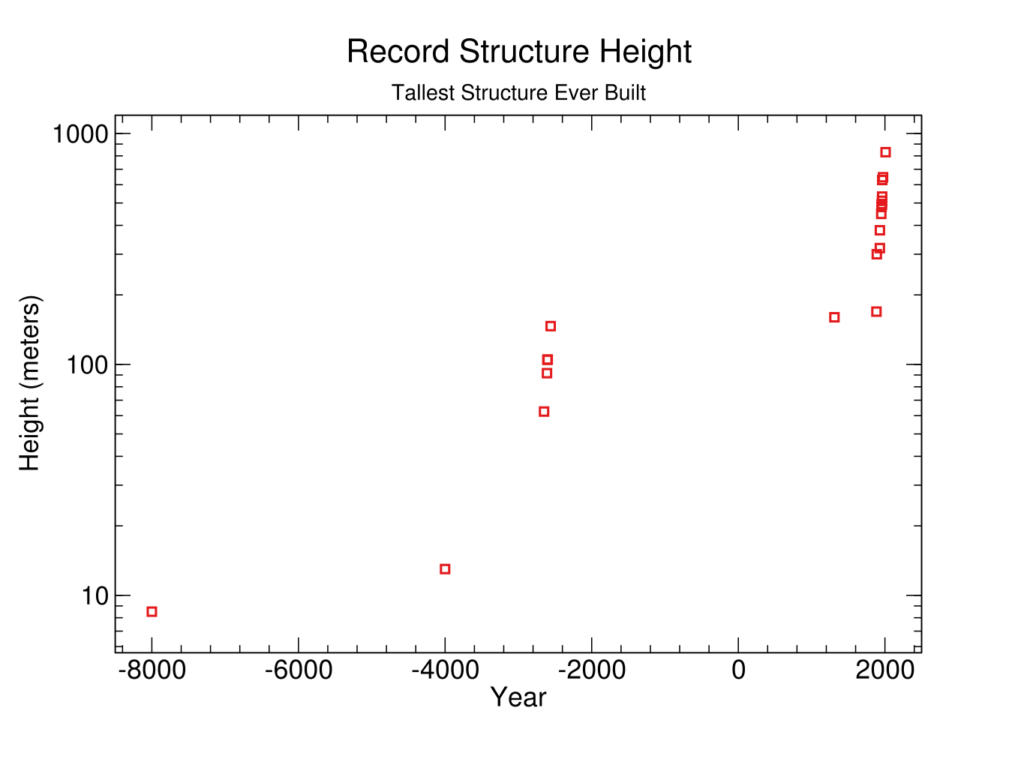
Discontinuity measurement
We treat this data as exponential initially followed by three linear trends. Using these trends as the previous rate to compare to, we calculated for each record how many years ahead of the trend it was.9 The series contained six unambiguous greater-than-ten-year discontinuities, shown in Table 1 below.
The Bent Pyramid appears to represent a 12 year discontinuity, but we ignore this because its date of construction seems uncertain relative to the small discontinuity.10
While our early records are presumably incomplete, we do not avoid measuring early discontinuities for this reason, because the large discontinuities that we find before the 19th Century seem unlikely to depend substantially on the exact set of earlier records.
Table 1: discontinuities in tallest ever structure heights
| Year | Height (m) | Discontinuity (years) | Structure |
| 2650 BC | 62.5 | ~9000 | Pyramid of Djoser |
| 2610 BC | 91.65 | ~1000 | Meidum Pyramid |
| 1884 | 169.3 | 106 | Washington Monument |
| 1889 | 300 | ~10,000 | Eiffel Tower |
| 1931 | 381 | 19 | Empire State Building |
| 1963 | 628.8 | 20 | KVLY-TV mast |
A number of other potentially relevant metrics are tabulated here.
Tallest ever freestanding structure heights
Data
This data is another subset of the ‘structures collection’ described above, this time including only records for ‘freestanding’ structures. This excludes structures supported by guy ropes, such as radio masts. Guyed masts were the tallest structures on land overall between 1954 and 2008, so this dataset differs from the ‘tallest ever structure heights’ dataset above between those years.
This dataset can be found in this spreadsheet, sheet ‘Freestanding structures (all time, pinnacle)’. Figures 4-5 below illustrate it.
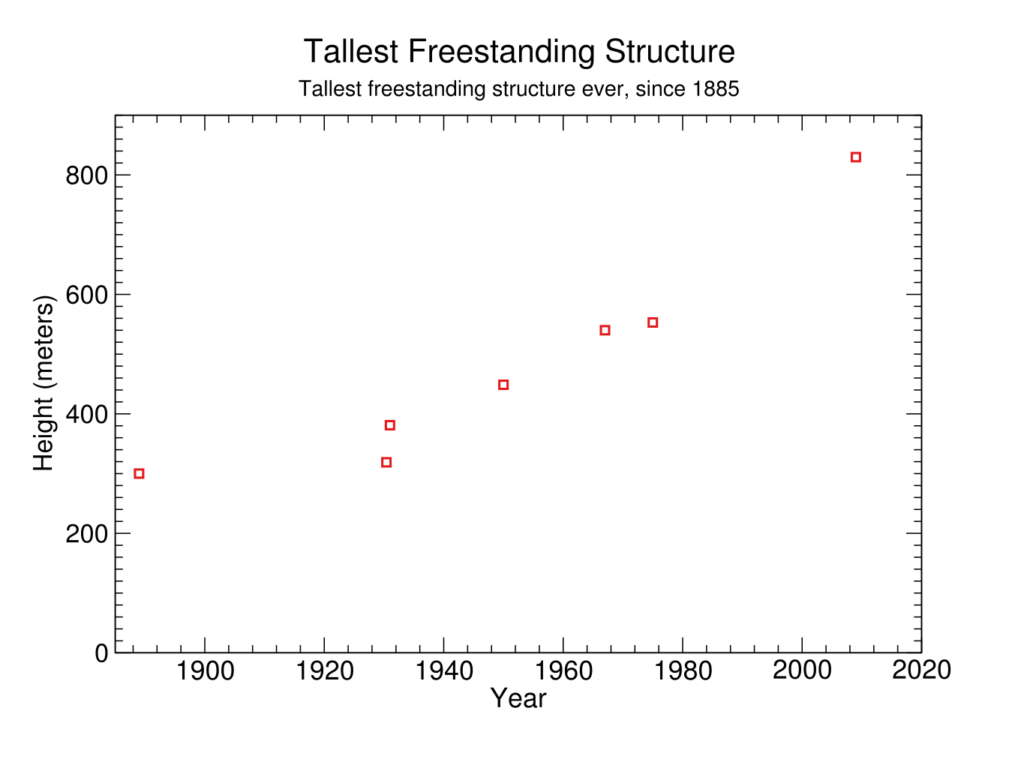
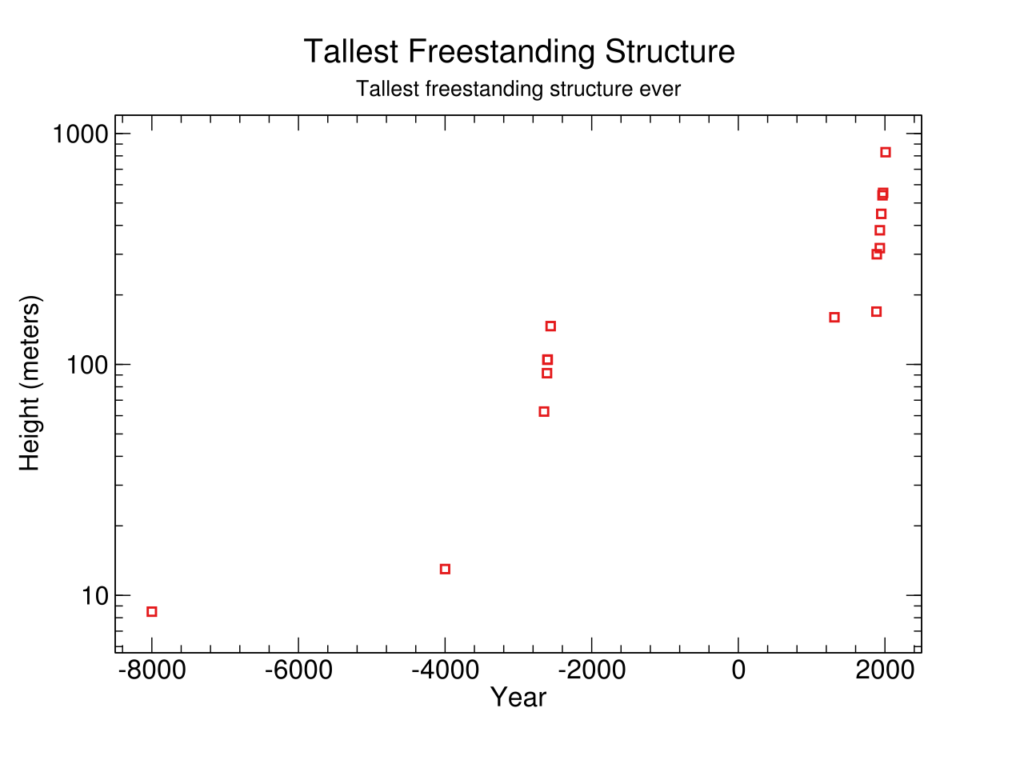
Discontinuity measurement
We treat this data as exponential initially followed by three linear trends. Using these trends as the previous rate to compare to, we calculated for each record how many years ahead of the trend it was.11 The series contained six unambiguous greater-than-ten-year discontinuities. The first five are the same as those in the previous dataset, since the series do not diverge until later (see Tallest ever structure heights section above for further details). The last discontinuity is a 32 year jump in 2009 from the Burj Khalifa.
We tabulated a number of other potentially relevant metrics here.
Tallest existing freestanding structure heights
We constructed a dataset of tallest freestanding structures over time largely from Wikipedia’s Timeline of world’s tallest freestanding structures12, with some modifications. This is available in our spreadsheet, sheet ‘Freestanding structures (current, pinnacle)’, and is shown in Figures 6-7 below.
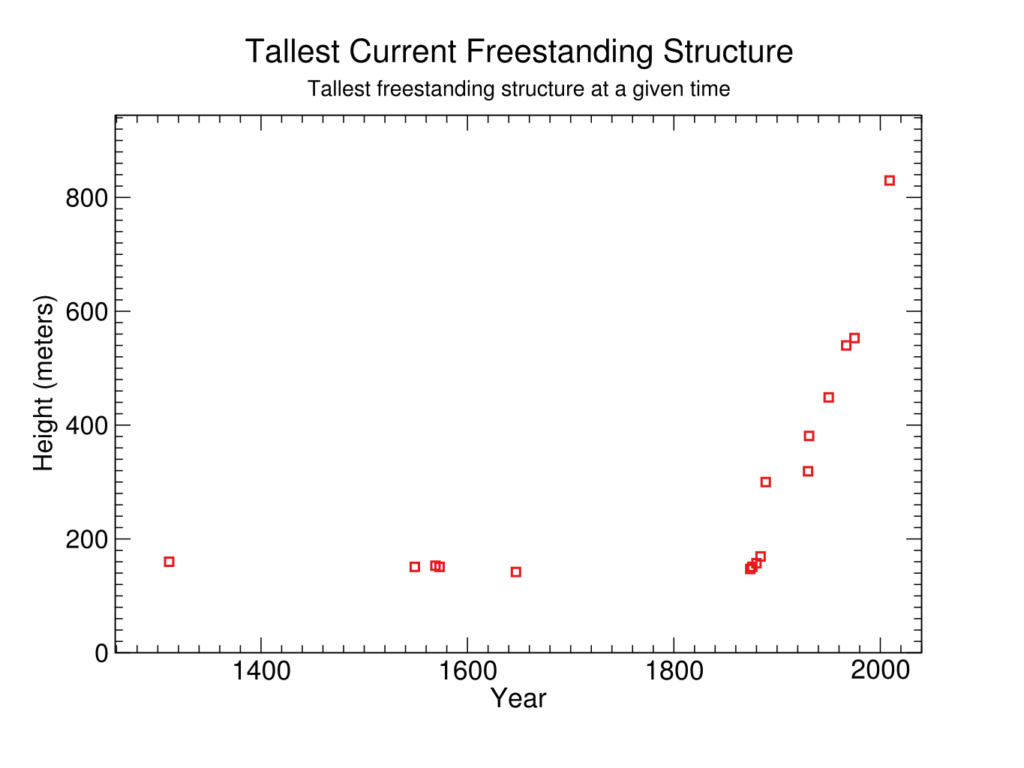
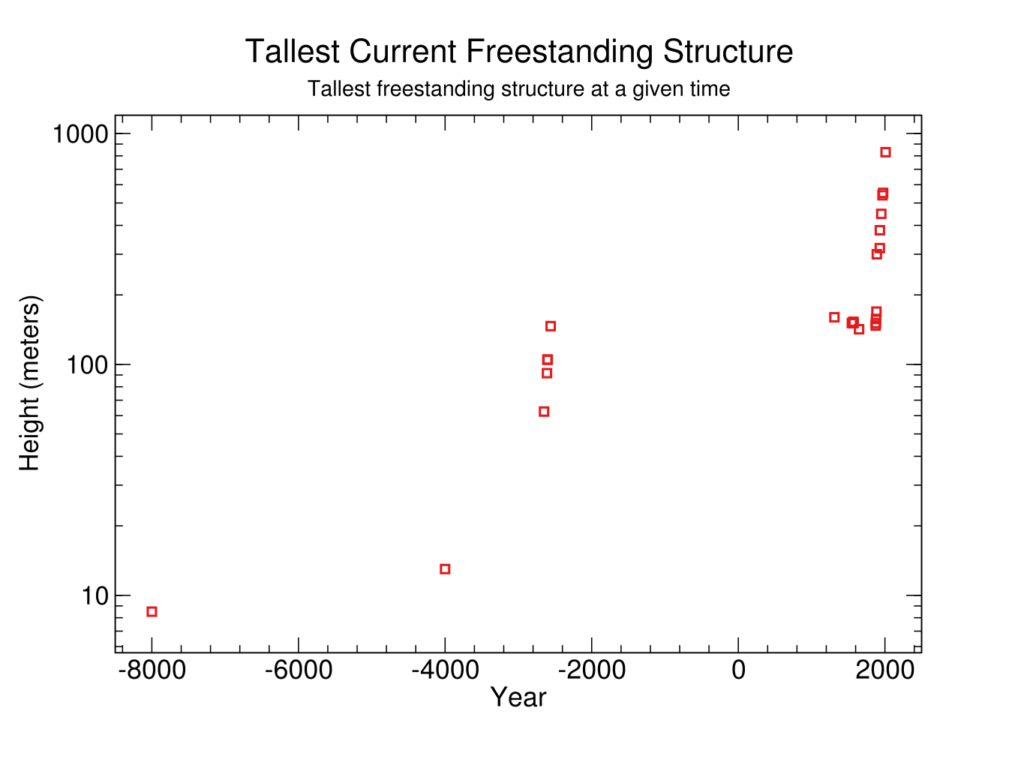
Discontinuity measurement
We treat this data as exponential initially, followed by four linear trends. Using these trends as the ‘previous rate’ to compare to,13 the data contained eight unambiguous greater than ten year discontinuities, shown in Table 2 below.14
This series differs from that of all-time tallest freestanding structures above by the insertion of a series of records between Lincoln Cathedral in 1311 and the Washington Monument in 1889. This change made the Washington Monument unexceptional rather than a 100 year discontinuity, and the Eiffel Tower a fifty-year discontinuity rather than a ten-thousand year one. Later discontinuities from the Empire State Building and Burj Khalifa are very similar.
Table 2: discontinuities in tallest existing freestanding structures
| Year | Height (m) | Discontinuity (years) | Structure |
| 2650 BC | 62.5 | ~9000 | Pyramid of Djoser |
| 2610 BC | 91.65 | ~1000 | Meidum Pyramid |
| 1569 | 153 | 138 | Beauvais Cathedral |
| 1874 | 147.3 | 224 | St Nikolai |
| 1876 | 151 | 307 | Rouen Cathedral |
| 1889 | 300 | 54 | Eiffel Tower |
| 1931 | 381 | 19 | Empire State Building |
| 2009 | 829.8 | 35 | Burj Khalifa |
We have tabulated a number of other potentially relevant metrics here.15
Tallest ever building heights
Data
We collected data on the tallest ever buildings from Wikipedia’s History of the world’s tallest buildings,16 and added it to this spreadsheet (sheet ‘Buildings (all time, architectural)’). We have not thoroughly verified it, but have made minor modifications (noted in the spreadsheet). Figure 8 shows this data.
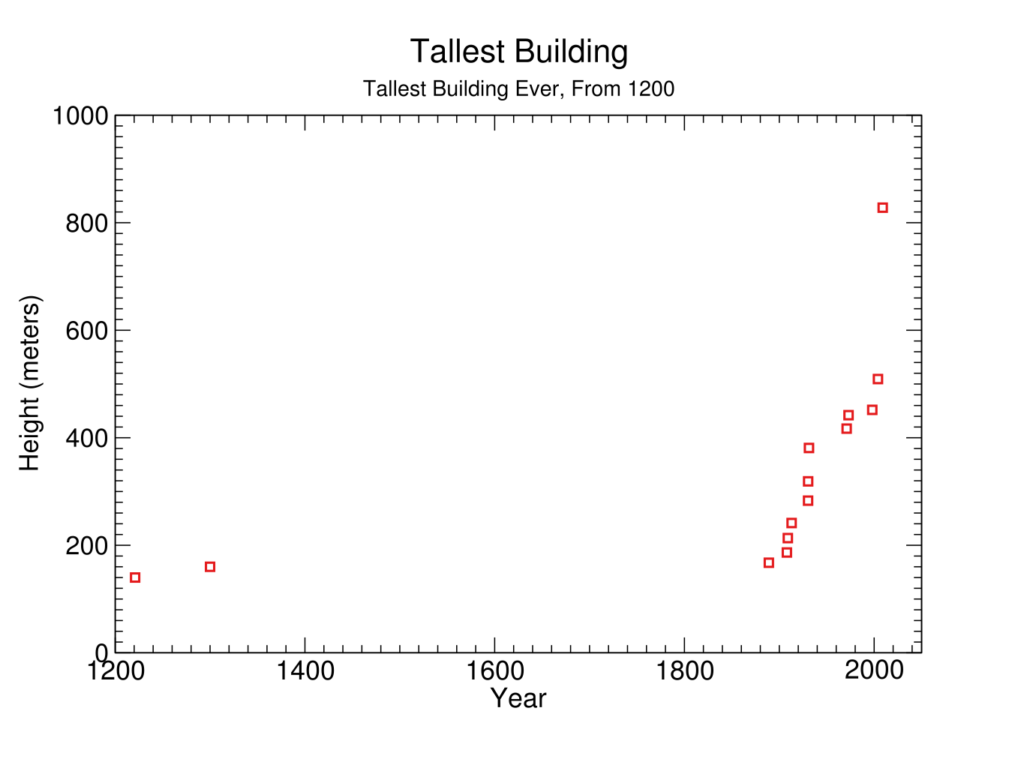

Discontinuity measurement
We treated this data as an exponential trend followed by a linear trend.17 Compared to previous rates within these trends, tallest buildings over time contained five greater than ten year discontinuities, shown in Table 3 below.18
Table 3: discontinuities in tallest ever building heights
| Year | Height (m) | Discontinuity (years) | Building |
| 1908 | 186.57 | 383 | Singer Building |
| 1909 | 213.36 | 320 | Metropolitan Life Tower |
| 1931 | 381 | 10 | Empire State Building |
| 2004 | 509.2 | 13 | Taipei 101 |
| 2010 | 828 | 90 | Burj Khalifa |
We have tabulated a number of other potentially relevant metrics here.19

Notes
- “However, though all of these are structures, some are not buildings in the sense of being regularly inhabited or occupied. It is in this sense of being regularly inhabited or occupied that the term “building” is generally understood to mean when determining what is the world’s tallest building. The non-profit international organization Council on Tall Buildings and Urban Habitat (CTBUH), which maintains a set of criteria for determining the height of tall buildings, defines a “building” as “(A) structure that is designed for residential, business or manufacturing purposes” and “has floors”.” – “History Of The World’s Tallest Buildings”. 2011. En.Wikipedia.Org. Accessed July 3 2019. https://en.wikipedia.org/w/index.php?title=History_of_the_world%27s_tallest_buildings&oldid=903623843
- “List of Tallest Freestanding Structures.” In Wikipedia, January 22, 2020. https://en.wikipedia.org/w/index.php?title=List_of_tallest_freestanding_structures&oldid=937089557.
- “The Petronius Platform stands 610 m (2,000 ft) off the sea floor leading some, including Guinness World Records 2007, to claim it as the tallest freestanding structure in the world. However, it is debated whether underwater height should be counted, in the same manner as height below ground is ignored on buildings.”
“List of Tallest Buildings and Structures.” In Wikipedia, February 2, 2020. https://en.wikipedia.org/w/index.php?title=List_of_tallest_buildings_and_structures&oldid=938797794.
- Definitions from CTBUH’s Skyscraper Center:
Height: Architectural Height is measured from the level of the lowest, significant, open-air, pedestrian entrance to the architectural top of the building, including spires, but not including antennae, signage, flag poles or other functional-technical equipment. This measurement is the most widely utilized and is employed to define the Council on Tall Buildings and Urban Habitat (CTBUH) rankings of the “World’s Tallest Buildings.”
Height: To Tip Height is measured from the level of the lowest, significant, open-air, pedestrian entrance to the highest point of the building, irrespective of material or function of the highest element (i.e., including antennae, flagpoles, signage and other functional-technical equipment).“The Skyscraper Center.” Accessed February 3, 2020. https://www.skyscrapercenter.com/definitions/Building.
- “History of the World’s Tallest Buildings,” in Wikipedia, July 19, 2019, https://en.wikipedia.org/w/index.php?title=History_of_the_world%27s_tallest_buildings&oldid=906924179.
- For instance, https://en.wikipedia.org/wiki/List_of_tallest_structures_built_before_the_20th_century, https://en.wikipedia.orug/wiki/List_of_tallest_buildings_and_structures#Tallest_freestanding_structures_on_land, https://en.wikipedia.org/wiki/List_of_tallest_freestanding_structures#Timeline_of_world’s_tallest_freestanding_structures, https://en.wikipedia.org/wiki/History_of_the_world%27s_tallest_buildings
- See our methodology page for details on how we choose what to treat as the ‘previous trend’ at a given point, and how we calculate discontinuities. See our spreadsheet, sheet ‘Structures (all time, pinnacle)’ for the division of our data into different trends and the discontinuity calculations.
- The pyramid is around 4600 years old, and for instance, the source we used had 2605 BC as its record date, whereas the pyramid’s own Wikipedia page gives ‘c 2600 BC’ as its date of construction.
“Bent Pyramid.” In Wikipedia, December 12, 2019. https://en.wikipedia.org/w/index.php?title=Bent_Pyramid&oldid=930419772.
- See our methodology page for details on how we choose what to treat as the ‘previous trend’ at a given point, and how we calculate discontinuities. See our spreadsheet, sheet ‘Freestanding structures (all time, pinnacle)‘ for the division of our data into different trends and the discontinuity calculations.
- “List of Tallest Freestanding Structures.” In Wikipedia, January 22, 2020. https://en.wikipedia.org/w/index.php?title=List_of_tallest_freestanding_structures&oldid=937089557.
- See our methodology page for details on how we choose what to treat as the ‘previous trend’ at a given point. See our spreadsheet, sheet ‘Freestanding structures (current, pinnacle)’ for the trends.
- We again ignore the Bent Pyramid, because the apparent discontinuity is small relative to uncertainty about its date of construction. See our methodology page for explanation of how we calculated discontinuities. Also see our spreadsheet, sheet ‘Freestanding structures (current, pinnacle)’ for these calculations.
- See our our methodology page for more details.
- See our methodology page for details on how we decide what to treat as the past trend for each point.
- See our methodology page for explanation of how we calculated these numbers. See our spreadsheet, sheet ‘Buildings (all time, architectural)’ for these calculations.
- See our methodology page for more details.

